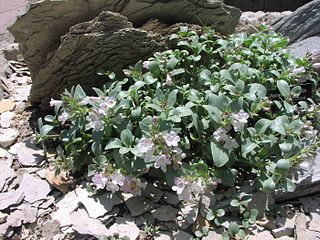
Penstemon debilis, the Parachute penstemon or Parachute beardtongue, is one of the rarest plants in North America, found only 5 places in the world, all of them located on the Roan Plateau in Garfield County, of Western Colorado. The Denver Botanic Gardens has the Parachute penstemon on display with other native plants of the Roan Plateau. The name Parachute comes from the small town in Colorado, Parachute, Colorado, close to where the plant can be found.
Enefit American Oil is a Utah based oil shale exploration and development company. It has been involved in the development of oil shale since 2005. Since 2011 it is a subsidiary of Eesti Energia, internationally known as Enefit.
Penstemon personatus is an uncommon species of penstemon known by the common name closethroat beardtongue.

Lepidium barnebyanum is a rare species of flowering plant in the family Brassicaceae known by the common names Barneby's pepperweed, Barneby's pepper-grass, and Barneby's ridge-cress. It is endemic to Utah, where there is a single population in Duchesne County. It is a federally listed endangered species of the United States.
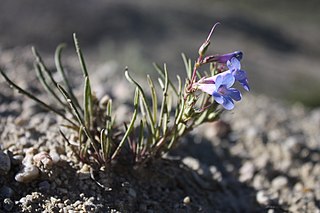
Penstemon penlandii is a rare species of flowering plant in the plantain family known by the common names Penland penstemon and Penland's beardtongue. It is endemic to Colorado in the United States, where it is known only from a strip of land about five miles long in central Grand County. There are two occurrences totalling about 8600 individuals. This is a federally listed endangered species of the United States.
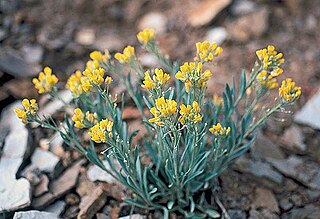
Physaria obcordata is a rare species of flowering plant in the family Brassicaceae known by the common name Dudley Bluffs twinpod. It is similar in appearance to the more common Piceance twinpod, but can be distinguished by looking at the leaves through a hand lens. The Piceance twinpod, Physaria acutifolia has stellate hairs when viewed through a hand lens while Physaria ocordata has markings that look like a satellite dish, or a circle with a dot in the middle. It is endemic to Colorado, where it is found only in the Piceance Basin in Rio Blanco County. It is threatened by the loss and degradation of its habitat. It is a federally listed threatened species of the United States.

Schoenocrambe argillacea is a rare species of flowering plant in the mustard family known by the common names clay reed-mustard, Uinta Basin plainsmustard, and clay thelypody.

Glaucocarpum is a monotypic plant genus containing the single species Glaucocarpum suffrutescens, a rare species of flowering plant in the mustard family known by the common names toad-flax cress, shrubby reed-mustard, Uinta Basin waxfruit and waxfruit mustard. It is endemic to Utah in the United States, where it is known only from Duchesne and Uintah Counties. It is threatened by habitat degradation and destruction. It is federally listed as an endangered species of the United States.
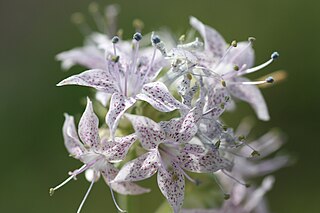
Ipomopsis polyantha is a rare species of flowering plant in the phlox family known by the common names Pagosa ipomopsis, Pagosa skyrocket and Archuleta County standing-cypress. It is endemic to Colorado in the United States, where it occurs only in the vicinity of Pagosa Springs in Archuleta County. It is threatened by the loss of its habitat to residential and commercial development. It was federally listed as an endangered species in 2011.

Phacelia submutica is a rare species of flowering plant in the borage family known by the common name De Beque phacelia. It is endemic to Colorado in the United States, where it is limited to the Piceance Basin in two counties. It is threatened by petroleum exploration. It was federally listed as a threatened species of the United States on July 27, 2011, a ruling which took effect on August 26, 2011.
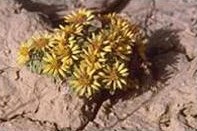
Townsendia aprica is a rare species of flowering plant in the family Asteraceae known by the common name Last Chance Townsend daisy. It is endemic to Utah in the United States, where it is known from three counties. It faces a number of threats and it is a federally listed threatened species of the United States.
Physaria parviflora is a species of flowering plant in the family Brassicaceae known by the common names Piceance bladderpod and frosty bladderpod. It is endemic to Colorado in the United States, where it occurs in Garfield, Mesa, and Rio Blanco Counties.

Penstemon degeneri is a species of flowering plant in the plantain family known by the common name Degener's beardtongue. It is endemic to Colorado in the United States, where it occurs in and around the Arkansas River Canyon in Fremont, Custer, and Chaffee Counties.

Penstemon gibbensii is a species of flowering plant in the plantain family known by the common name Gibbens' beardtongue. It is native to the western United States, where it occurs in Wyoming, Colorado, and Utah.

Penstemon scariosus is a species of flowering plant in the plantain family known by the common name White River beardtongue. It is native to Colorado, Utah, and Wyoming in the United States.
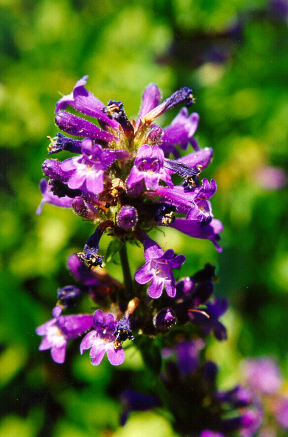
Penstemon attenuatus is a species of flowering plant in the plantain family known by the common names sulphur penstemon and taperleaf beardtongue. It is native to the northwestern United States.
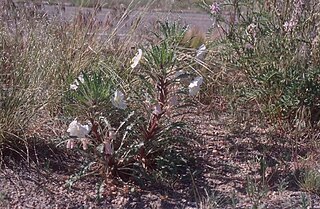
Oenothera harringtonii is a species of flowering plant in the evening primrose family known by the common names Arkansas Valley evening primrose and Colorado Springs evening primrose. It is endemic to the state of Colorado in the United States.

Physaria congesta is a rare species of flowering plant in the mustard family known by the common name Dudley Bluffs bladderpod. It is endemic to western Colorado in the United States, where it is known only from seven occurrences in Rio Blanco County. It is federally listed as a threatened species.

Penstemon whippleanus, commonly known as dusky penstemon, dusky beardtongue, Whipple's penstemon, or Whipple's beardtongue, is a summer blooming perennial flower in the large Penstemon genus. It is a widespread plant within the hemiboreal forests of the Rocky Mountains in North America. It is noted for the large deep purple-red flowers and a preference for high mountain elevations.
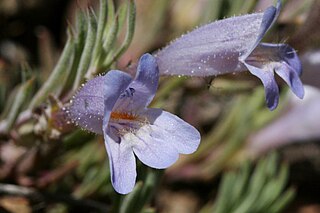
Penstemon caespitosus, commonly known as mat penstemon, is a summer blooming perennial flower in the large Penstemon genus. It is a widespread plant from near timberline to the foothills in the Southern Rocky Mountains and Colorado Plateau in North America. It is noted for its ground hugging growth habit and as a plant used in xeriscape and rock gardening.


















